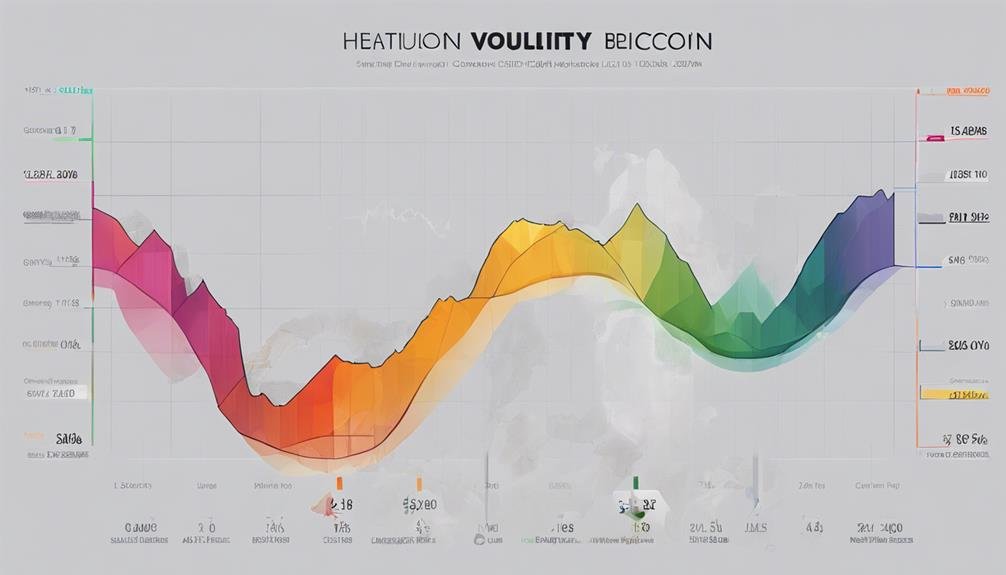When comparing Bitcoin’s volatility with other cryptos like Ethereum, Ripple, Litecoin, and Stellar, distinct price fluctuations and market behaviors emerge. Altcoins like Ethereum and Ripple display higher volatility due to various factors like market cap and trading dynamics. Ripple offers stability during market downturns, contrasting Bitcoin’s intense reactions to price shifts. Ethereum’s volatility stems from network upgrades and NFT trends, impacting its price swings significantly. Litecoin exhibits lower average daily volatility than Bitcoin, appearing as a potentially less risky investment. Stellar’s price remains less volatile, influenced by market demand. Understanding these comparisons can guide strategic investment decisions for best portfolio management.
Table of Contents
Brief Overview of Comparing Bitcoins Volatility To Other Cryptocurrencies
- Due to market dynamics, altcoins like Ethereum, Litecoin, and Ripple exhibit higher volatility than Bitcoin.
- Ripple shows lower volatility compared to Bitcoin, appealing to investors seeking stability.
- Ethereum displays higher volatility with significant price swings influenced by network upgrades and market trends.
- Litecoin offers lower average daily volatility than Bitcoin, making it a potentially less risky investment.
- Stellar demonstrates lower price volatility than Bitcoin, which is influenced by market demand and network applications.
Bitcoin Vs Altcoins: Volatility Analysis
When comparing Bitcoin to altcoins in terms of volatility, it becomes evident that some alternative cryptocurrencies display significantly higher price fluctuations than Bitcoin. Altcoins like Ethereum, Litecoin, and Ripple have shown higher volatility levels than Bitcoin in specific periods. This difference in volatility can be attributed to various factors such as market capitalization, liquidity, and the dynamic nature of cryptocurrency trading. With their smaller market capitalization and lower liquidity than Bitcoin, Altcoins are more susceptible to sharp price movements in the market.
Analysts often use advanced statistical models like GARCH models and dynamic conditional correlation to study the volatility of digital currencies. Bitcoin’s market dominance plays a significant role in influencing overall market volatility, impacting altcoins differently. Due to its established history and position in the market, traders frequently use Bitcoin as a benchmark to assess volatility in altcoins. Understanding the volatility dynamics between Bitcoin and altcoins is essential for investors looking to navigate the cryptocurrency market effectively.
Ripple Vs Bitcoin: Price Fluctuations

In comparing Ripple to Bitcoin regarding price fluctuations, Ripple has demonstrated lower volatility with more stable movements over time. Ripple’s price has shown resilience during market downturns, offering investors a more stable option than Bitcoin’s price swings. While Bitcoin often experiences higher peaks and troughs, Ripple exhibits smoother and more gradual price movements, providing predictability that appeals to those seeking less volatility.
The market’s response to Bitcoin fluctuations can be rapid and intense, making it a more challenging investment for some individuals. On the other hand, Ripple’s price fluctuations are generally more controlled, offering a sense of stability that can reassure investors. Ripple’s price volatility has proven to be less pronounced than Bitcoin’s, making it a potentially attractive choice for those looking for a more stable investment option in the cryptocurrency market.
Ethereum Vs Bitcoin: Market Swings

Comparing Ethereum with Bitcoin in terms of market swings reveals a pattern of higher volatility in Ethereum, characterized by more significant percentage fluctuations within shorter periods. Ethereum’s price movements are influenced by various factors such as network upgrades, DeFi trends, and NFT booms. These elements contribute to the increased volatility seen in Ethereum compared to Bitcoin. The market swings in Ethereum can be substantial, reflecting changing investor sentiment and market dynamics.
Additionally, the correlation between Ethereum and Bitcoin prices is pivotal in impacting investors’ trading strategies and portfolio diversification. It is essential to note that Ethereum’s price often reacts more sensitively to market news and developments, leading to amplified swings in value. Understanding these dynamics is vital for investors navigating the volatile cryptocurrency market and developing effective trading strategies tailored to Ethereum’s unique market behavior.
Litecoin Vs Bitcoin: Comparative Volatility

Litecoin’s relative volatility against Bitcoin presents a distinct contrast in daily price fluctuations that can influence investment decisions based on risk preferences. With Litecoin’s lower average daily volatility compared to Bitcoin, around 3.41%, versus Bitcoin’s 4.64%, it emerges as a less risky investment option. This difference in volatility levels signifies Litecoin’s relative stability in the trading environment. Investors seeking a more predictable market with smoother price movements may find Litecoin appealing.
While occasional spikes can occur, Litecoin generally maintains a calmer trajectory, reflecting its lower volatility. Analyzing the comparative volatility of Litecoin and Bitcoin is essential for making informed decisions tailored to individual risk tolerance and prevailing market conditions. Understanding these dynamics can empower investors to navigate the crypto landscape and position themselves strategically in response to price fluctuations.
Stellar Vs Bitcoin: Price Variability

When considering price variability between Stellar and Bitcoin, one can observe a notable difference in their levels of volatility. Stellar tends to have lower price volatility than Bitcoin, making it a relatively stable investment choice. Over the past few years, Bitcoin has exhibited more significant price fluctuations than Stellar. Market demand, network applications, and mainstream adoption influence Stellar’s price variability.
On the other hand, Bitcoin’s price dynamics are often driven by market sentiment, trading volumes, and macroeconomic factors. Analyzing the price variability between Stellar and Bitcoin provides valuable insights into their market dynamics and investment potential. Understanding how these cryptocurrencies respond to various market forces and price fluctuations is essential for investors looking to navigate the volatile world of digital assets. By delving into the intricacies of price movements, one can make informed decisions regarding investment strategies in these two prominent cryptocurrencies.
Frequently Asked Questions
Which Crypto Has Highest Volatility?
When comparing volatility among cryptocurrencies, Ethereum typically shows lower volatility than Bitcoin. Ripple and Litecoin also exhibit less volatility than Bitcoin. Dogecoin’s movements are more unpredictable than Ethereum’s and often experience higher volatility.
Is Bitcoin More Volatile?
Bitcoin is indeed more volatile. Its stability in the crypto market affects investor risk tolerance. Price prediction accuracy is essential amidst market speculation trends. Understanding volatility’s impact on trading aids in financial risk management strategies.
Which Crypto Will Be Better Than Bitcoin?
Regarding potential, Ethereum stands out for its technological advancements. Ripple’s forecast as a financial partner is promising. Litecoin’s growth in transaction speeds and lower fees is notable. Dash’s outlook is optimistic. Monero’s comparison is unique. Stellar’s performance is solid. Cardano’s analysis shows robust scalability. EOS’s speculation is positive. IOTA’s trends indicate growth. NEO’s future looks bright.
Are Altcoins More Volatile Than Bitcoin?
Altcoins tend to be more volatile than Bitcoin due to factors like a smaller user base and speculative trading. Their volatility trends vary when comparing Ethereum, Ripple, Litecoin, Dogecoin, Cardano, Polkadot, Binance Coin, Solana, Chainlink, and Stellar.
Conclusion
To sum up, when comparing Bitcoin’s volatility to other cryptocurrencies like Ripple, Ethereum, Litecoin, and Stellar, it is evident that Bitcoin remains at the forefront with its price fluctuations. While some altcoins may show variability, none can match the extreme swings of Bitcoin. Investors should carefully consider the risks and rewards of each cryptocurrency before making decisions. Remember, in the crypto world, Bitcoin’s volatility is like a rollercoaster ride on steroids, not for the faint-hearted.




